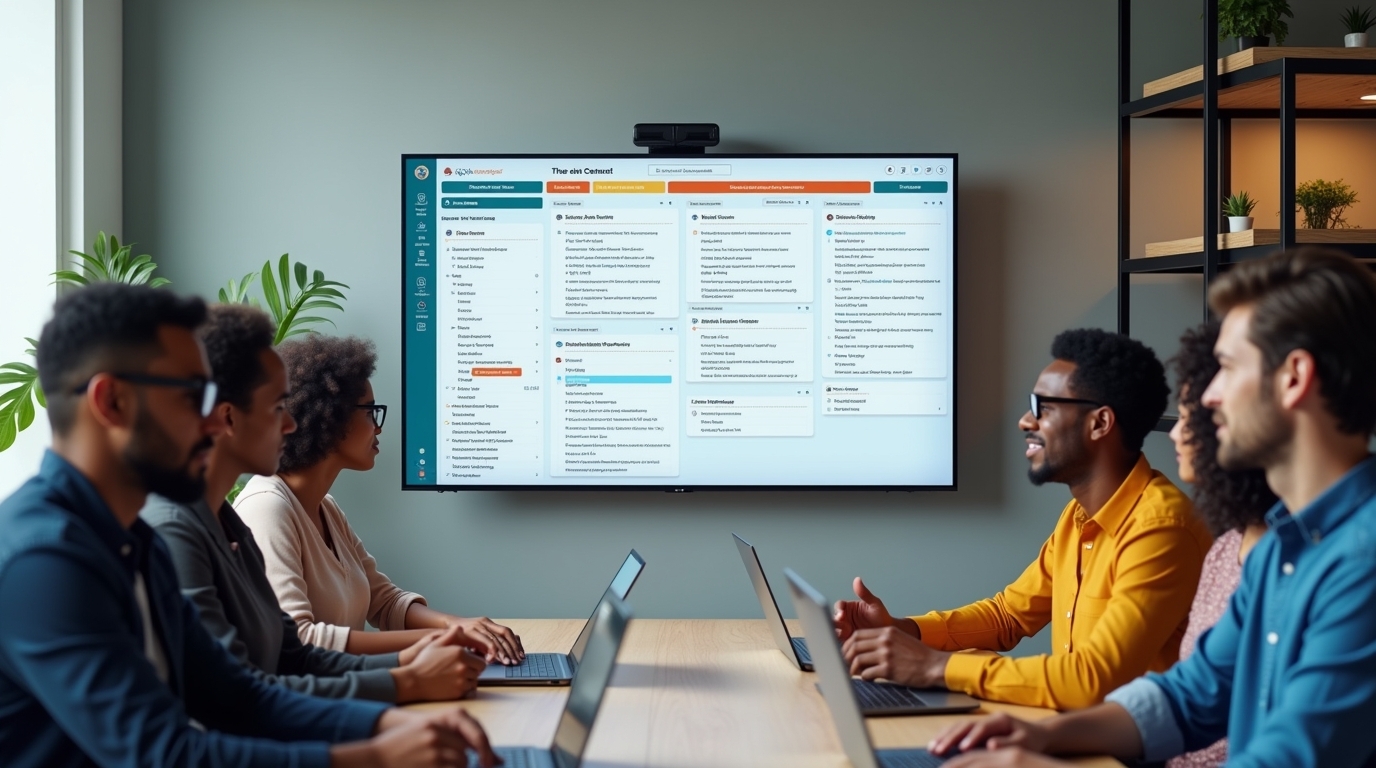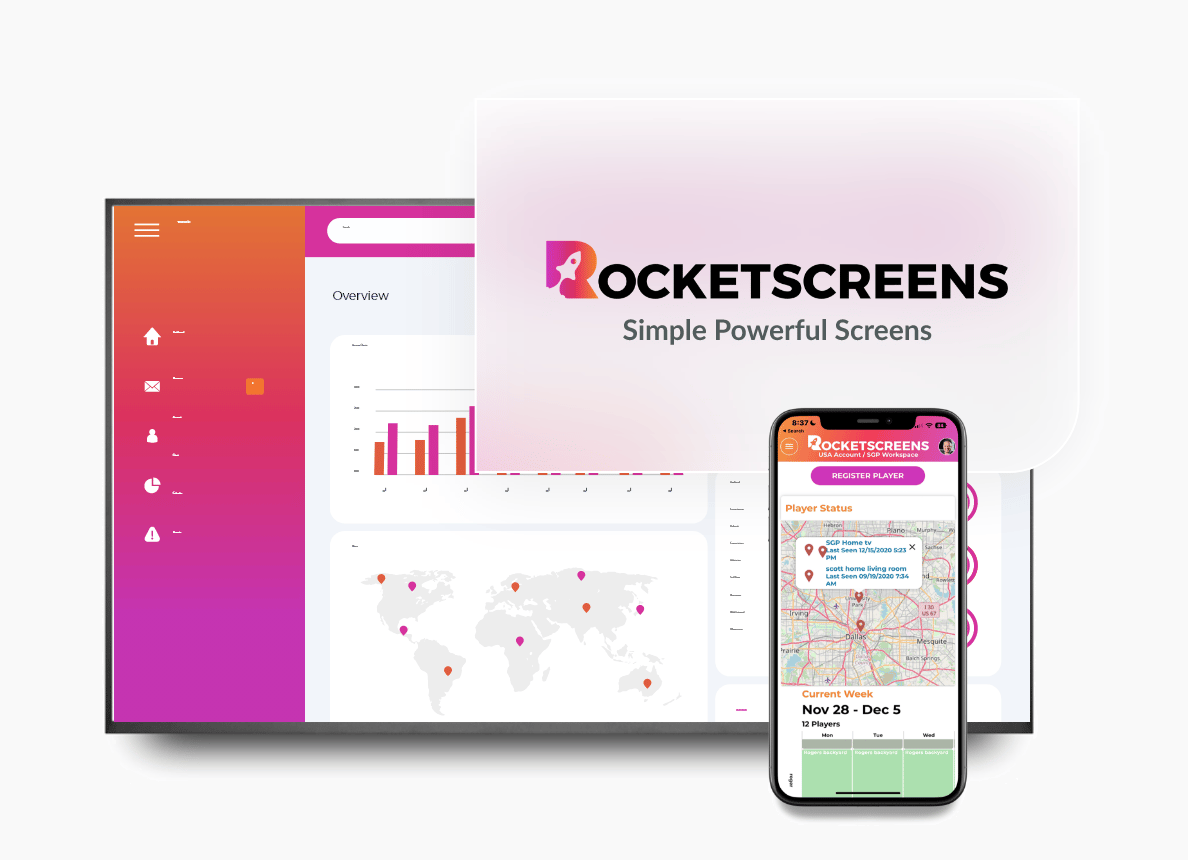
In the fast-paced world of project management, keeping your team aligned and informed is crucial for success. For many, Jira is the central hub for tracking tasks, managing workflows, and keeping projects on schedule. But what if you could take that valuable information out of individual screens and make it a visible, dynamic part of your team's environment? This is where the combination of Jira and digital signage comes in, creating a powerful tool for transparency and real-time project tracking.
This guide will walk you through the ins and outs of using Jira with digital signage. We'll explore what Jira is, the benefits of visualizing its data, and how you can use a platform like RocketScreens to display your Jira dashboards on screens around your office. Get ready to see your projects in a whole new light.
What is Jira?
Jira is a powerful software application developed by Atlassian that helps teams of all sizes manage their work. Originally designed as a bug and issue tracker for software developers, it has since evolved into a versatile project management tool used by a wide range of teams, from marketing and HR to IT and operations.
At its core, Jira allows you to create, assign, and track tasks (or "issues" in Jira terminology) through a customizable workflow. This means you can map out the exact stages a task goes through, from "To Do" to "In Progress" and "Done." This flexibility makes it a popular choice for teams that follow agile methodologies like Scrum and Kanban.
Core Functionalities
- Issue Tracking: The heart of Jira, allowing teams to capture and organize all tasks, bugs, and project-related items in one place.
- Customizable Workflows: You can design workflows that match your team's specific processes, ensuring a smooth and consistent way of working.
- Scrum and Kanban Boards: Visual boards that help agile teams manage their work, plan sprints, and keep track of progress.
- Reporting and Dashboards: Jira offers a variety of reports and customizable dashboards that provide insights into your team's performance and project status.
- Integrations: Jira connects with a wide range of other tools, from developer tools to communication platforms, creating a unified workspace.
Who Uses Jira?
While Jira's roots are in software development, its use has expanded to include a variety of teams:
- Software Development Teams: For bug tracking, sprint planning, and managing the entire development lifecycle.
- Marketing Teams: To manage campaigns, content creation, and creative projects.
- IT and Support Teams: For handling service requests, managing incidents, and tracking support tickets.
- Project Managers: To get a high-level overview of projects, track progress, and ensure deadlines are met.
- Business Teams: For general task management, workflow approvals, and keeping track of deliverables.
The Power of Visualizing Jira Data
While Jira is excellent at organizing and tracking project information, the true potential is unlocked when you can visualize that data in a clear and accessible way. Visualizing your Jira data helps to turn complex information into easy-to-understand insights that can be shared with your entire team.
Why Visualizing Data is Important for Teams
- Improved Transparency: When everyone can see the status of projects and tasks, it creates a culture of transparency and accountability.
- Better Collaboration: Visual dashboards can spark conversations and help team members identify areas where they can help each other.
- Faster Decision-Making: With real-time data on display, teams can make quicker, more informed decisions without having to dig through reports.
- Increased Motivation: Seeing progress in real-time can be a great motivator for teams, helping them to stay focused and engaged.
Benefits of Real-Time Project Tracking
When you track your projects in real-time and make that information visible to everyone, you gain a number of advantages:
- Early Problem Detection: With a live view of your projects, you can spot bottlenecks and potential issues before they become major problems.
- Keeps Everyone on the Same Page: Real-time tracking ensures that the entire team is working with the most up-to-date information.
- Celebrates Successes: When a task or project is completed, seeing it updated on a shared display is a great way to celebrate small wins and keep morale high.
- Reduces the Need for Status Meetings: With project information readily available, you can cut down on the number of status meetings and let your team focus on their work.
Taking Jira to the Big Screen: Digital Signage Integration
One of the most effective ways to visualize your Jira data is by displaying it on digital signage. A Jira wallboard, which is a dashboard displayed on a large screen or TV, can serve as a central information hub for your team, providing a constant, at-a-glance view of your projects.
Introducing Digital Signage for Project Management
Digital signage is no longer just for advertising or displaying welcome messages. It's a powerful tool for internal communication and data visualization. By connecting your project management tools to digital screens, you can create a dynamic and engaging way to keep your team informed.
This is where a platform like RocketScreens comes in. RocketScreens makes it simple to connect your Jira account and display your dashboards on any screen. You can securely pull data from over 100 applications, including Jira, and create customized layouts that show the information that matters most to your team.
How RocketScreens and Jira Work Together
With RocketScreens, you can easily set up a connection to your Jira account and start displaying your project data. Here's how it works:
- Connect Your Jira Account: Securely link your Jira account to RocketScreens.
- Choose Your Dashboards: Select the Jira dashboards or specific projects you want to display.
- Customize Your Display: Use RocketScreens' intuitive interface to design how your Jira data will look on screen.
- Publish to Your Screens: Push your Jira wallboard to any screen in your office, from the main team area to breakout rooms.
The result is a live, automated display of your project's progress, visible to everyone. No more having to remind team members to check Jira—the information is right there, in front of them.
Practical Use Cases for Jira on Digital Signage
Displaying your Jira data on digital signage can benefit a variety of teams. Here are a few practical examples:
For Development Teams
- Sprint Burndown Charts: Show the progress of the current sprint, helping the team to stay on track.
- Kanban Boards: Display the team's Kanban board to visualize the flow of work and identify any blockages.
- Bug Tracking: Keep a running list of critical bugs that need to be addressed, ensuring they don't get overlooked.
For Marketing Teams
- Campaign Dashboards: Track the progress of marketing campaigns, from content creation to launch.
- Content Calendars: Display the content calendar to keep everyone aware of upcoming deadlines and publications.
- Project Timelines: Show the timeline for larger marketing projects, helping to coordinate efforts across the team.
For Support Teams
- Live Ticket Queues: Display the current number of open support tickets and their priority levels.
- Service Level Agreement (SLA) Status: Keep track of SLA performance to ensure that customer issues are being resolved in a timely manner.
- Team Performance Metrics: Show key metrics like response times and customer satisfaction scores to motivate the team.
How to Set Up Your Jira Dashboard with RocketScreens
Getting your Jira dashboard up on a screen with RocketScreens is a straightforward process. Here’s a conceptual guide to get you started:
- Sign Up for RocketScreens: If you haven’t already, create an account with RocketScreens.
- Add a New App: In the RocketScreens dashboard, you'll find an option to add a new application. Search for and select "Jira."
- Authenticate Your Jira Account: You'll be prompted to enter your Jira credentials to securely connect your account. This ensures that only your data is accessed.
- Select Your Content: Once connected, you can choose what you want to display. This could be a specific project board, a custom dashboard, or a filtered list of issues.
- Design Your Layout: RocketScreens offers a variety of templates and customization options. You can choose to display your Jira board full-screen or as part of a multi-zone layout with other information, like company announcements or social media feeds.
- Assign to a Screen: Finally, assign your newly created Jira content to one or more of your screens. Within moments, your Jira dashboard will be live for your whole team to see.
Tips for Creating an Effective Jira Wallboard
To get the most out of your Jira wallboard, it's important to think about what information you're displaying and how it's presented. Here are a few tips:
What to Include
- Key Performance Indicators (KPIs): Focus on the metrics that matter most to your team's success.
- Actionable Information: Display data that can help your team make decisions or take action.
- A Mix of High-Level and Detailed Views: Show an overview of project progress, but also be prepared to drill down into specific tasks if needed.
- Keep it Simple: Avoid cluttering your wallboard with too much information. A clean, easy-to-read display is more effective.
What to Avoid
- Information Overload: Don't try to display everything at once. Rotate between different dashboards or create multiple focused wallboards for different teams.
- Outdated Information: Ensure that your wallboard is displaying real-time data. A simple refresh setting can take care of this.
- Complex Charts: Use simple, clear charts and graphs that can be understood at a glance.
By bringing your Jira data out into the open with digital signage, you can create a more transparent, collaborative, and productive work environment. Whether you're a development team tracking sprints or a marketing team managing campaigns, a Jira wallboard can help you keep your projects on track and your team aligned. With a platform like RocketScreens, getting started is easier than ever. It’s time to put your data to work and give your team the visibility they need to succeed.





